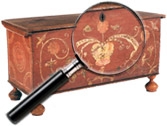|
|
Mellier & Co.
Mellier & Co. operated at 2 Frith Street, near Soho Square, and later Margaret Street. They advertised themselves as “specialists in the rich decorative styles of the sixteenth, seventeenth and eighteenth centuries”. They became best known for their fine examples of antique French furniture and were among the English manufacturers who exhibited at the 1904 St Louis International Exhibition.
Information courtesy of Neal Auction Company, December 2005
Pottier & Stymus
A premier New York cabinet making firm, Pottier and Stymus was known for high-style furniture in the Neo-Grec, Renaissance Revival, Egyptian Revival and Modern Gothic styles. With beginnings in the 1840′s, the firm moved to the 375 Lexington Street address between 41st and 42nd Streets in 1871.
Pottier & Stymus Manufacturing Company used a number to identify each completed piece and the same number for each of its component parts, in [...] Click here to continue reading.
Timothy Pickering (1745 – 1829)
Timothy Pickering was born in Salem, Massachusetts, in July 1745. He graduated from Harvard University in 1763, studied law and was admitted to the bar in 1768, serving for some time as Register of Deeds for Essex County. Initially, Pickering was reluctant to sever ties with Great Britain but reconsidered his position and played a vital role in the Revolution’s success. He accepted General Washington’s offer to become Adjutant [...] Click here to continue reading.
Aaron Burr
Burr served with distinction in the Continental Army at the battles of Quebec, Monmouth, and New Haven. He is best remembered for taking the life of Alexander Hamilton in an 1804 duel. After conspiring with General James Wilkinson to create a new republic in the Southwest, he was arrested in 1807, tried for treason, and acquitted. He went abroad in 1808 and tried but failed to interest the English and French in [...] Click here to continue reading.
Jugendstil Movement
In the late 19th century there was an artistic Renaissance in southern Germany, led by the artists and designers of the Jugendstil movement in the area around Munich. While Jugendstil artists like Arnold Bocklin are often thrown in with the French Art Nouveau artists of the same period, their art was stylistically original and focused on Germanic themes and mythology.
The term “Jugendstil” originated in 1896, when it was published in the [...] Click here to continue reading.
Peter Gunnarson Rambo (1612-1698)
Peter Rambo, founder of the Rambo family of Philadelphia, left Sweden at the age of twenty-seven as a laborer for the New World Trading Company, setting sail on the “Kalmar Nyckel” for the colony of New Sweden (Delaware). Gunnarson chose Rambo as his surname in remembrance of his birthplace, Gothenburg, which is dominated by Ramberget or Raven’s Mountain, overlooking Gothenburg’s harbor. He arrived in 1640 and after serving his indenture, [...] Click here to continue reading.
John Henry Sievers-Texas Furniture Maker
John Henry Sievers (1841 to 1920) was born in Germany and immigrated with his family to Castroville, Texas as a young child. He was trained in the rigorous German cabinet making tradition continued in the Central Texas immigrant community. Sievers established the J.H. Sievers Altar Manufacturing company in San Antonio. The company supplied furniture not only in Texas, but also in Louisiana, New Mexico and Arizona throughout the late [...] Click here to continue reading.
Richard & Rosemarie Machmer Provenance
The following remembrances were publishing the Pook and Pook auction catalogue for this sale, held on October 24 and 25, 2008. For coverage of this sale, please see the account in Maine Antique Digest, published in January of 2009, available at http://www.maineantiquedigest.com/stories/index.html?id=1014.
About thirty-five years ago, I traveled around two hours to an evening country auction in Schnecksville, Pennsylvania. As I walked into the auction house, facing me was [...] Click here to continue reading.
Ormolu
Ormolu, an 18th-century English term, is from the French phrase or moulu, with “or” indicating gold and “moulu” being a form of an old French verb moudre, which means “to grind up.” (This French term for this technique is bronze dore.) This idea of “ground-up gold”refers to the production process of ormolu, where high-quality gold is finely powdered and added to a mercury mixture and applied to a bronze object.
In reality, [...] Click here to continue reading.
Oldenburg, Indiana
The Midwestern Germanic settlement of Oldenburg, Indiana, was initially settled in 1817 by Pennsylvania emigre William George and his brother, Oldenburg soon became the destination of the many German immigrants landing in Cincinnati. In 1837, William Flaspholer and William Ronnenbaum purchased the George brothers’ farm and platted the town, making provisions for a park, school, church, cemetery, and market place.
As the nineteenth century progressed, more immigrants, many of whom had come [...] Click here to continue reading.
|
Recent Articles
- Charles Alfred Meurer – American Artist & Tromp L’Oeil Artist
- Sendak, Maurice – American Artist & Writer
- Godie, Lee – American Artist
- Davis, Vestie – American Artist
- Bartlett, Morton – American Artist
- Mackintosh, Dwight – American Artist
- Evans, Minnie Jones – African-American Artist
- Mumma, Ed (Mr. Eddy) – American Artist
- Nice, Don – American Artist
- Savitsky, John (Jack) – American Artist
- Gordon, Harold Theodore (Ted) – American Artist
- Dial, Thornton – African-American Artist
- Doyle Sam – American Artist
- Johnson, Lester Frederick – American Artist
- Finster, Howard – American Artist
|
|
